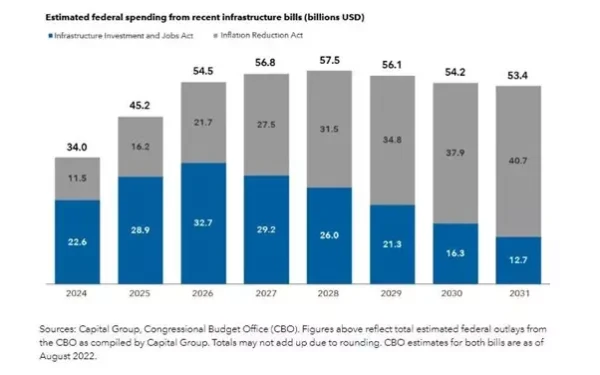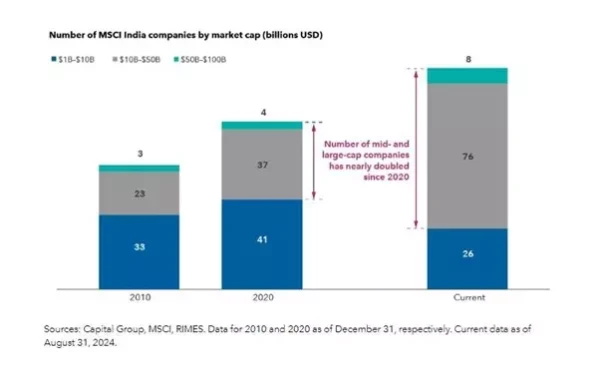Beyond The “Magnificent”: Five Big Growth Themes To Watch
Nothing stays the same forever – and that’s especially true in the market. While Big Tech stocks still hold the crown, smart investors are diversifying and looking beyond those titans. They’ve got very real concerns about concentration risk – having too much exposure to just a handful of massive companies. So they’re looking for ways to balance their portfolio, seeking out new growth assets, while not letting go of their tech winners completely.
Capital Group, one of the world’s biggest asset managers, has some ideas on that front. Here are five places where the firm sees growth in the next five years.
First and foremost, tech. The giants keep growing, but so does their ecosystem.
Let’s be clear here: the big dogs of technology – Meta, Nvidia, Apple, Microsoft – aren’t slowing down. In fact, they’re expanding in ways that make traditional growth barriers irrelevant. Take Meta, which slashed its workforce yet managed to grow revenue by 22% in 2024. Or Nvidia, whose gaming chips have become must-haves for AI processing, sending its sales skyrocketing from $11 billion in 2020 to $60 billion in 2024. That’s not just a growth story: it’s a scale story.
What does this mean for you? Those Magnificent Seven names – Microsoft, Nvidia, Meta, Apple, Amazon, Alphabet, and Tesla – do tend to hog the spotlight, but the ecosystem surrounding them is just as important – and possibly less volatile. Companies that provide the infrastructure – like data centres, chip designers, and utility providers – are primed to benefit from Big Tech’s relentless expansion. Firms like Broadcom, TSMC, and ASML – key players in the semiconductor space – may offer growth opportunities without the wild swings of direct tech investments.
Industrials. They’ve got high barriers, big moats, and serious potential.
Beyond tech, industries like defence, energy, and infrastructure are quietly building moats – those high barriers to entry that make it tough for competitors to catch up. The US and Europe are pouring billions into moving their supply chains closer to home and boosting their energy security, setting the stage for a massive investment Supercycle. Eaton, a US-based electrical products company, is a prime example. Its backlog of orders has grown from $2.8 billion in 2019 to over $11 billion in 2024. Similarly, Schneider Electric, which helps commercial buildings become more energy-efficient, is projecting solid growth through 2027.
Even niche areas like aerospace are booming. Companies like Lockheed Martin and Raytheon are getting a boost from rising global defence budgets, with military expenditures hitting a staggering $2.4 trillion in 2023.


What does this mean for you? Industrials might not have the glitz and cutting-edge appeal of tech, but with steady cash flows and high barriers to entry, these companies are long-term winners. Companies like Eaton, Schneider Electric, AES, and NextEra – involved in power generation, energy efficiency, and defence – are especially well-positioned for sustainable growth.
Healthcare. It’s a growth story for the ages.
Healthcare often flies under the radar, but it’s a sector that investors would be wise to keep an eye on – especially right now. In 2022, healthcare spending in the US hit an eye-watering $4.5 trillion, and, as the population ages, that number seems only to go up. What’s more, we’re riding a third wave of innovation, driven by genetics and AI.
One of the most exciting developments is gene therapy, which allows scientists to tackle diseases at the genetic level. Companies like Alnylam are leading the charge with RNAi therapeutics – essentially “silencing” genes that cause diseases. Meanwhile, Vertex Pharmaceuticals recently won approval for a sickle cell disease treatment created using innovative CRISPR gene editing technology.
What does this mean for you? Healthcare stocks as a group are undervalued compared to the broader market, but the potential for innovation is massive. Look for companies at the forefront of gene therapy, AI in healthcare, and cutting-edge drug development. Eli Lilly and Novo Nordisk are dominating the obesity drug market. Vertex is leading in gene therapy. These companies could drive significant returns as the healthcare sector evolves.
Consolidated industries. Dominant players lead the pack.
Some companies are so commanding in their industries, it’s hard to imagine anyone knocking them off their perch. Think about it – LVMH and Hermès practically own their lane in the luxury goods market, while TSMC controls 80% of the world’s advanced computing chips. Netflix? Still the king of streaming. Meta and Google? They have an iron grip on online advertising.
But it’s not just tech and luxury enjoying this kind of dominance. Companies like Caterpillar (heavy machinery), Costco (retail), and Airbus (aviation) have built empires that are tough to topple. Years of industry consolidation, a well-honed business model, and a lack of serious competition make these companies especially resilient.
What does this mean for you? Leader-of-the-pack companies are often more resilient to market swings. Mind you, they’re not immune to setbacks – long-dominant Boeing has seen a string of troubles, for example – but over time, they tend to deliver solid returns. If you’re looking for stability and long-term growth, keep an eye on these industry bosses.
India. It’s the next big market.
Step aside, China – India’s taking the spotlight. With a booming economy, a thriving private sector, and a rapidly expanding middle class, India is shaping up to be the next major growth market. It’s on a development trajectory that mirrors China’s of 20 years ago, offering massive potential in manufacturing, consumer goods, and technology.
India’s mid-cap companies are particularly exciting: they’ve nearly doubled in numbers in the past four years. And there are huge growth opportunities for the country’s small-cap firms. These businesses – with market caps ranging from $1 billion to $10 billion – now make up a third of the MSCI India index. Sectors like housing, healthcare, and consumer finance are flourishing as the middle class grows. India is also emerging as a strong alternative to China for manufacturing, especially in electronics and home appliances. With heavy government investment in infrastructure and digital connectivity, these companies have plenty of room to scale.


What does this mean for you? India presents a massive growth opportunity for patient, long-term investors. The country’s private sector is full of high-quality companies that are poised for serious growth. With global growth expected to pick up again, this might be a good time to explore emerging markets in general – and India, in particular.
The big takeaway here is this: although the Magnificent Seven stocks have been stealing the spotlight, other places offer the potential for strapping growth too. And that’s good – no one wants to put all their eggs in one basket. Remember: diversify across a few key themes, stay patient, and keep a long-term view. You'll be well-positioned to ride the growth wave over the next five years.